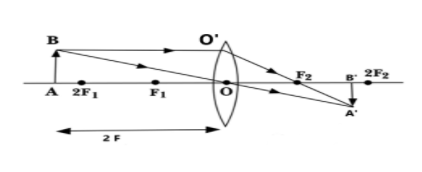
The image of an object is formed by a convex lens. When that object is placed beyond the focal length is –
A. Virtual and inverted
B. Virtual and magnified
C. Real and inverted
D. Real and magnified
Answer
552k+ views
Hint: The propagation of light takes place in the form of straight lines or rays. The path of rays of light are governed by the laws of reflection and refraction at the interfaces between different media. The device which produces converging or diverging light rays due to refraction is known as a lens.
Complete answer:
Lens acts as the transmissive optical device that focuses or disperse a beam of light by the method of refraction. Lenses can be simple or compound. The simple lenses are made up of a single piece of transparent material but compound lenses consist of several simple parts that are arranged in a common axis.
Most of the lenses show two types of surfaces which are convex surfaces and concave surfaces. The convex surfaces are bulged outwards from the lens. The concave surfaces are depressed inside the lens. The image formed through a convex lens takes place as a collimated light beam passes through the lens and converges to a spot behind the lens. The spot is referred to as the focus.
In the above situation when that object is placed beyond the curvature center causes a light ray to pass through the focus F2. This light ray is parallel to the principal axis and moves along the direction of O’F2. The other ray which is BO passes through the center and it moves on straight without any types of deviation.
The light rays are refracted. The two rays then intersect with each other at the point A’. A’ point lies between the F2 and 2 F2 on the opposite side of the lens. Thus, the image that is formed is a real and inverted image B’A’. The real image is formed because the object is located at a greater distance which is more than one focal length from the lens. The image is diminished in nature.

Hence, the correct answer is option (C).
Note: Convex lenses are bulging lenses and cause to create image at a focus point behind the lens. The image formed when that object is placed beyond the focal length is real, diminished and inverted in nature due to the point of intersection of the two rays. The two rays intersect at the other side of the lens resulting in this type of image.
Complete answer:
Lens acts as the transmissive optical device that focuses or disperse a beam of light by the method of refraction. Lenses can be simple or compound. The simple lenses are made up of a single piece of transparent material but compound lenses consist of several simple parts that are arranged in a common axis.
Most of the lenses show two types of surfaces which are convex surfaces and concave surfaces. The convex surfaces are bulged outwards from the lens. The concave surfaces are depressed inside the lens. The image formed through a convex lens takes place as a collimated light beam passes through the lens and converges to a spot behind the lens. The spot is referred to as the focus.
In the above situation when that object is placed beyond the curvature center causes a light ray to pass through the focus F2. This light ray is parallel to the principal axis and moves along the direction of O’F2. The other ray which is BO passes through the center and it moves on straight without any types of deviation.
The light rays are refracted. The two rays then intersect with each other at the point A’. A’ point lies between the F2 and 2 F2 on the opposite side of the lens. Thus, the image that is formed is a real and inverted image B’A’. The real image is formed because the object is located at a greater distance which is more than one focal length from the lens. The image is diminished in nature.

Hence, the correct answer is option (C).
Note: Convex lenses are bulging lenses and cause to create image at a focus point behind the lens. The image formed when that object is placed beyond the focal length is real, diminished and inverted in nature due to the point of intersection of the two rays. The two rays intersect at the other side of the lens resulting in this type of image.
Recently Updated Pages
Master Class 12 Business Studies: Engaging Questions & Answers for Success

Master Class 12 Economics: Engaging Questions & Answers for Success

Master Class 12 English: Engaging Questions & Answers for Success

Master Class 12 Maths: Engaging Questions & Answers for Success

Master Class 12 Social Science: Engaging Questions & Answers for Success

Master Class 12 Chemistry: Engaging Questions & Answers for Success

Trending doubts
What is meant by exothermic and endothermic reactions class 11 chemistry CBSE

Which animal has three hearts class 11 biology CBSE

10 examples of friction in our daily life

One Metric ton is equal to kg A 10000 B 1000 C 100 class 11 physics CBSE

1 Quintal is equal to a 110 kg b 10 kg c 100kg d 1000 class 11 physics CBSE

Difference Between Prokaryotic Cells and Eukaryotic Cells




